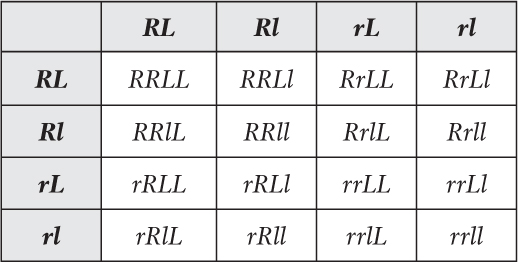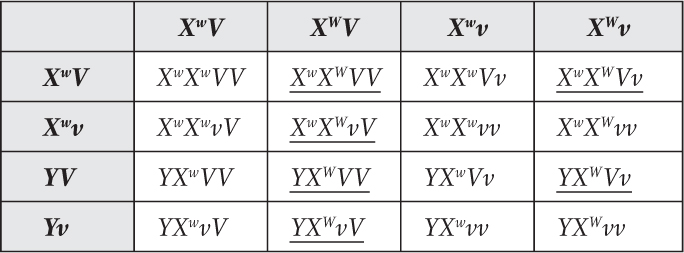Chapter Introduction
104: Solutions to Problems
S-
Chapter 2
Question 2.1
(a) Plants with round seeds, 100%. (b) Plants with round seeds, 75%; plants with wrinkled seeds, 25%. (c) Plants with round seeds, 50%; plants with wrinkled seeds, 50%.
Question 2.2
At least one of the parents was RR. The other parent was RR, Rr, or rr.
Question 2.3
One parent was RR, and the other was Rr. In the F1 generation, half of the plants were RR and half were Rr. In the F1 crosses, all crosses involving RR plants (three-
Question 2.4
Recall that this eye-
Question 2.5
The F1 generation will have XWY males (all red-
Question 2.6
The gene producing the black color is on the Y chromosome. It is not present in any females, regardless of the generation. There are no other Y chromosomes in the population, so all males have the black trait.
Question 2.7
All F1 offspring are RrLl plants, with red flowers and large leaves. The F2 generation is shown in the Punnett square.

9/16, or 56.25%, have red flowers and large leaves; 3/16, or 18.75%, have red flowers and small leaves; 3/16, or 18.75%, have white flowers and large leaves; 1/16, or 6.25%, have white flowers and small leaves.
Question 2.8
100% of the F1 generation plants would have pink flowers. In the F2 generation, 50% would have pink flowers.
Question 2.9
12.5% of the F2 males will have red eyes and normal wings; these are marked in the Punnett square by an underline. They all have genotypes with at least one XW gene and one V gene.

Question 2.10
The G and S genes are linked: they are found on the same chromosome and are sufficiently close together that crossovers between them are rare. Thus, the G and S alleles are not independently assorted.
Question 2.11
In mitosis, the paired chromosomes (in the sister chromatid pair) are separated, and one chromatid passes to each daughter cell. In meiosis, the sister chromatids are not separated but instead remain paired in the daughter cells produced by the first division.
Question 2.12
Genes A, B, C, and E are on one chromosome, unlinked to genes D and F. Relative distances between genes are indicated by numbers under each chromosome.
Chromosome 1:

Chromosome 2:

Question 2.13
M O N or N M O
Question 2.14
Characteristics of rRNAs: only a few types in a cell; located in ribosomes; sequence highly conserved in different life forms; are functional RNAs (do not encode proteins). Characteristics of tRNAs: small; fold into a characteristic L shape; have many modified bases; can link to an amino acid; are functional RNAs. Characteristics of mRNAs: the most diverse of the RNAs in sequence—
S-
Question 2.15
Hershey and Chase could have done the work with a single batch of phage with both radioactive labels. After the blending step, the 35S-
Question 2.16
Genes trpD and trpE are involved in step 1, trpC in step 2, and trpA and trpB in step 3. The results suggest that the enzymes catalyzing steps 1 and 3 each consist of at least two polypeptides encoded by separate genes.
Question 2.17
In mitotic cell division, the sister chromatid pairs are separated following replication: A1 and A1* go to different daughter cells, and A2 and A2* go to different daughter cells. In the first cell division of meiosis, the two sets of sister chromatids stay together, with one set going to each of the two daughter cells: A1/A1* goes to one cell, and A2/A2* goes to the other.
Question 2.18
There are many possible answers; these suggestions focus on answers that might come from a student with a limited background in molecular biology. Some of the RNAs could have catalytic functions. Others could be cofactors for protein enzymes. Some could pair with RNA or DNA to regulate processes involving these nucleic acids. Some could be associated with RNA viruses.